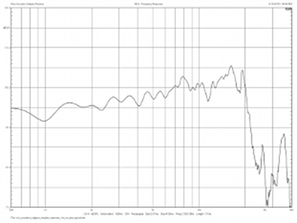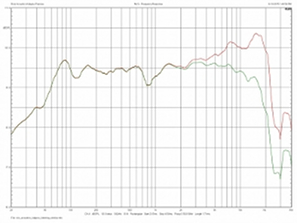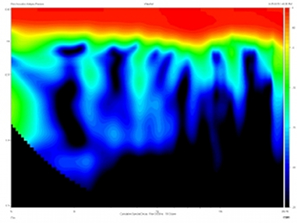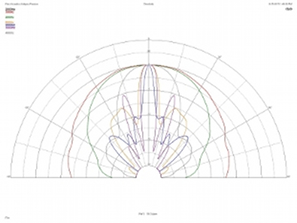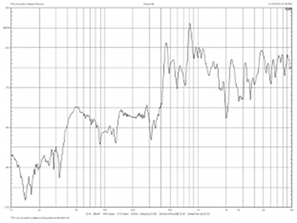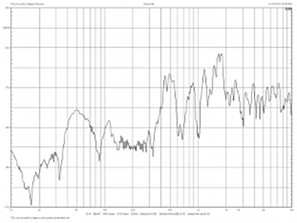about Audio, High Fidelity
& Home Entertainment technologies
pid: 607-2025/10/01 (v1.2)
Privacy Policy

Kalypso's quasi-anechoic response (for frequencies higher than 500Hz) shows that the loudspeaker's behavior is determined primarily by the response of the driver itself in the middle and upper-frequency range, which is expected given that this is a single driver full range design. The graph features a series of small amplitude deviations which appear in rather narrow frequency intervals and a clear sensitivity increase towards the high-frequency part of the spectrum, followed by a fast cut-off above 20kHz.
Summed frequency response, resulting from splicing a near field and a quasi-anechoic measurement is a better estimator of the overall tonal balance of the loudspeaker and Kalypso is -indeed- a quite balanced design, especially in the mid and high-frequency band. This response was obtained without the -2dB attenuation network, which showed to improve the loudspeaker's behavior at higher frequency signals. Average sensitivity was estimated at 96.8dBSPL/2.83Vrms/1m and, based on this value, the -3dB cut-off points are near 65Hz and 22.3kHz for low and high-frequency signals respectively, while the -6dB cut-off points are at 58Hz and 22.7kHz. Sensitivity deviations are rather low. Points worth considering here, are a 2dB increase around 85Hz and a sensitivity decrease in the 600-1200Hz interval. The latter, could probably be attributed to the splicing algorithm used for producing the summed response, however, the quasi-anechoic measurement also includes a similar behavior (mind the different scales in the frequency axis between the graphs, here), so chances are this a feature of the loudspeaker.
Of particular interest is also the averaged, listening window response, resulting from in- and off-axis measurements, both in the horizontal and in the vertical plane. The most obvious finding here is a quite strong roll-off at the high-frequency region (indicating that the loudspeaker features a high directivity character, which is an expected discovery). Most important, however, is that the listening window response reveals that Kalypso, in practice is quite smooth, remaining well within the typically ±3dB interval, except for the 85Hz peak.
Quasi-anechoic frequency response (dBSPL/2.83V/m) above 500Hz, measurement at 2m distance.
Summed frequency response (dBSPL/2.83V/m), far field/near field splicing, with 0.33oct smoothing. On-axis (red curve) and averaged on/off axis response (green curve).
Kalypso appears to be a load that behaves well, with a minimum impedance magnitude close to 8 Ohm at low-frequency signals (8.3 Ohm/35Hz) a value that confirms the claims made by Rois. Phase variation is such that it will not create any difficulties for an amplifier to drive the loudspeaker while overall impedance magnitude variation (about 21 Ohm) can be regarded as good and will typically generate only small changes in the system frequency response if the amplifier is characterized by a low damping factor.
Step response of the loudspeaker is smooth without major problems during its decay, offering evidence of a good transient behavior.
The cumulative spectra decay graph includes a number of discrete resonances in the high-frequency range which, however, fade quickly enough. More important seem to be the ones at 2.3kHz and 4kHz (1.6 and 1.3mS for a decay below -25dBr, respectively.
From the averaged, listening window response, it is evident that the Kalypso is a quite directional loudspeaker, a fact confirmed by the polar response measured in the horizontal plane. Here, it seems that the -6dB attenuation angle drops rapidly with frequency and reaches 40° at 4kHz, a value above which the radiation lobe narrows visibly and quickly including some beaming. These findings suggest that the best listening position for Kalypso is one in a small distance from the loudspeakers, which -by the way- should be toed-in for optimal performance in the high-frequency part of the spectrum. Also, it is advisable to identify and control the early room reflections, probably by adding some absorption or diffusion to compensate for the limited radiation of the loudspeaker at higher frequencies.
Cumulative Spectral Decay graph, on-axis, quasi-anechoic measurement.
Polar response diagrams in the horizontal plane. Frequencies : 1kHz (red curve), 2kHz (green curve), 4kHz (gray curve), 8kHz (orange curve), 16kHz (purple curve) and 20kHz (blue curve ).
Finally, despite the size of the loudspeaker, cabinet coloration appears to be low, probably because of the internal folded horn which strengthens the entire structure. Baffle acceleration Vs frequency graph includes two clear resonances at 450Hz and 800Hz which are, however, at low levels (less than -50dBm/S2).
The side walls of the loudspeaker also proved quite neutral, with major resonances appearing between 400Hz and 2kHz, but to an even lower level.
Front baffle acceleration analysis in the frequency domain. Measurement with the accelerometer positioned near baffle center.
Side panel acceleration analysis in the frequency domain. Measurement with the accelerometer positioned in the center of the side panel.
Previous | Next | More Reviews

